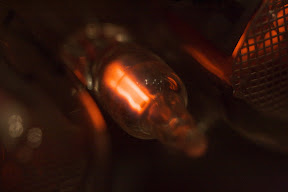Satashnik: a Nixie Clock
 Nixie Tubes: ИН-2
Nixie Tubes: ИН-2Microcontroller: ATmega8
RTC: DS3234 TCXO
Power Supply: 7-12V
This table-top clock is very compact.
Hardware design

Satashnik primarily differs from Patashnik in display technique. In Patashnik, each tube is controlled independently at any time. In this clock, only one ID1 decoder/driver is used and the tubes are multiplexed, or scanned in sequence, hence the name.
Usage of one ID1 greatly saves board space and microcontroller pins. The drawbacks are the necessity of high-side transistor valves for anode selection and brightness limit, which is now 1/4 of full brightness tops because only one tube can be lit at the same time.For the best space utilization, the circuit is assembled on two boards. The main board carries most components and the daughterboard mounted at right angle carries the nixies and high-side transistor switches.
Everything else comes straight from Patashnik.
Firmware
 The firmware is a substantial improvement over Patashnik code. Quite a few
bugs were fixed, most noticeably the summer->winter DST switch
moment. The display, crossfades, dot-blinking code is all mostly new
of course because these functions are implemented differently in
multiplexed displays. Curiously, dot blinking is a fairly
complex feature.
The firmware is a substantial improvement over Patashnik code. Quite a few
bugs were fixed, most noticeably the summer->winter DST switch
moment. The display, crossfades, dot-blinking code is all mostly new
of course because these functions are implemented differently in
multiplexed displays. Curiously, dot blinking is a fairly
complex feature.IN-35 is a pretty whimsical little neon lamp. One could make a fairly reliable random data source with such bulb. The time it takes this bulb to light up is very random and it doesn't depend very much on the voltage applied. It does heavily depend on the amount of ambient light however. The natural way of dealing with this would be to keep this lamp open all of the time, but at a very low intensity. However, unlike a LED, it can't be PWM'ed at any random frequency with any taken at will duty cycle. I had to experiment a little to find a frequency at which the lamp would shimmer briefly at 1/128th duty cycle but never really go out. The frequency is pretty high and the overhead is large, but the CPU has nothing better to do anyway so it works.
Satashnik has a self-diagnosis high voltage meter mode. Since voltage booster is fully controlled by the ATmega, it knows current voltage at the output of voltage converter and can display it. If everything is okay, the voltage is always the same so it's only interesting when tube saving mode is switched on and off. Satashnik can be switched into lower-voltage and shorter duty cycle manually, or it can enter into such mode during the night time which may be useful if it's used as an office clock.
Enclosure
The enclosure was prototyped with a toilet paper roll core:
More pictures can be seen in my 18:38 album.
Files
- Schematic: [mainboard] [daughterboard]
- Eagle Project [github]
-
Source Code [github] [docs]
References
- Patashnik Nixie Clock
- MAX1771-based high-efficiency Nixie power supply
-
 DS3234 Extremely Accurate RTC with SPI Bus, Integrated Crystal, and SRAM
DS3234 Extremely Accurate RTC with SPI Bus, Integrated Crystal, and SRAM
- How to build a Nixie Clock (Tutorial on AVRFreaks)
- Часы на газоразрядных индикаторах ИН-12Б (РадиоКот)
-
Слонс (aplomb.nl)
- Switching Power Supply Design (aplomb.nl)
-
История паташника в классическую эпоху (Топос)
- Patashnik (Alone) (cgsociety.org)
- Patashnik by Señor Salme
—-—
Address of this page: https://sensi.org/~svo/satashnik/
All Rights Reserved
Copyright © 2010 Viacheslav Slavinsky svofski on gmail
Fri Sep 30 10:55:09 UTC 2016


